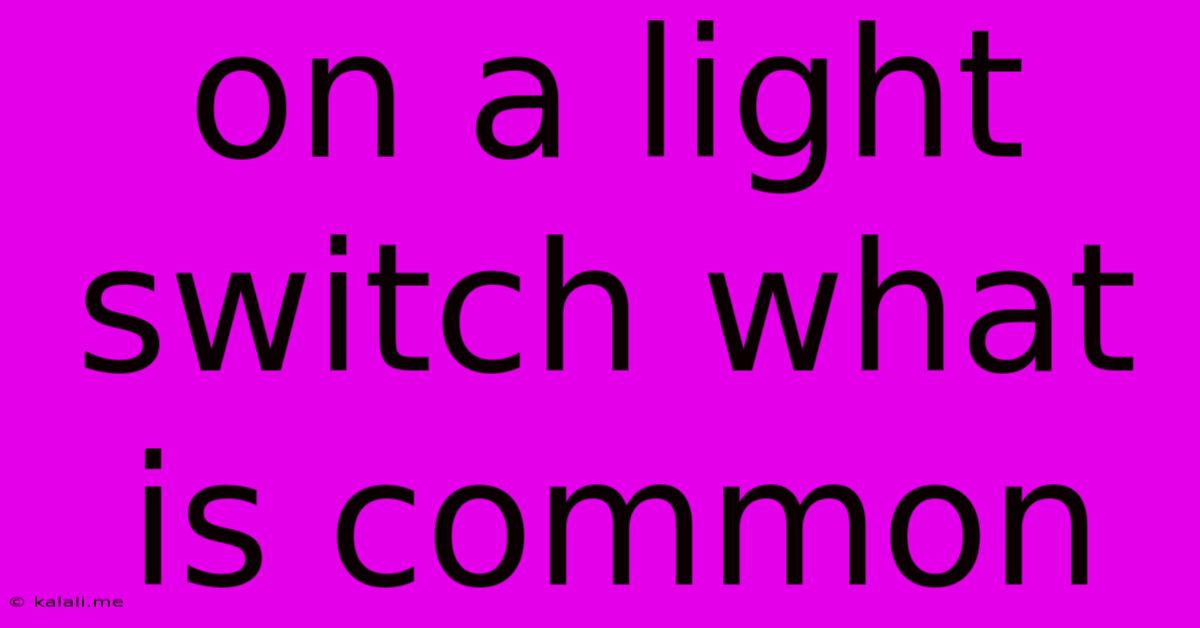On A Light Switch What Is Common
Kalali
May 21, 2025 · 3 min read

Table of Contents
On a Light Switch: What is Common? Understanding Electrical Wiring
This article will demystify the common terminal on a light switch, explaining its function, importance in electrical circuits, and how it relates to other components. Understanding this crucial element is vital for anyone working with electrical systems, even for basic DIY projects. We'll explore common types of light switches and how the common terminal plays a role in each.
What is the Common Terminal?
The common terminal on a light switch is the connection point that carries the power from the electrical source to the switch. It's the main pathway for the electricity to flow. It's usually identified by a different screw color (often brass or a darker color than the other terminals), or clearly labeled “COM”, “Common”, or even with a diagram on the switch itself. Think of it as the central hub through which power enters and exits the switch mechanism.
How the Common Terminal Works
When the switch is in the "ON" position, the common terminal connects the incoming power to the switched terminal(s), completing the circuit and allowing electricity to flow to the light fixture or appliance. When the switch is "OFF," the common terminal disconnects the power, interrupting the circuit and turning the load off.
Types of Light Switches and the Common Terminal
The function of the common terminal remains consistent across different types of light switches, but the number of terminals and their configuration might vary:
-
Single-pole switches: These have two terminals: a common and a switched terminal. They control a light from one location. The common receives the power, and the switched terminal sends the power to the light when the switch is on.
-
Three-way switches: These switches allow you to control a light from two different locations. They have three terminals: a common, a traveler, and another traveler. The common terminal still receives the power, but the travelers carry the signal between the two switches.
-
Four-way switches: These are used in conjunction with three-way switches to control a light from three or more locations. They have four terminals, usually marked as two "common" and two "traveler" terminals, working in tandem with the three-way switches to manage the power flow. The function of the common remains similar – it passes power through the circuit.
Safety Precautions When Working with Light Switches
Before undertaking any electrical work, always turn off the power at the breaker box. Never work with live wires. If you are uncomfortable working with electricity, it's best to consult a qualified electrician. Incorrect wiring can lead to electrical hazards and damage to your equipment.
Troubleshooting Issues Related to the Common Terminal
Problems with the common terminal usually manifest as the light not working at all. This often points to a loose connection, faulty wiring or a problem at the power source. Inspect the wiring carefully, ensuring all connections are tight and secure. If the problem persists, a qualified electrician should be called to investigate.
Conclusion: The Common Terminal's Significance
The common terminal on a light switch is a fundamental component in electrical circuits. Its role in controlling the power flow underscores its importance for the functioning of lighting and other electrical appliances. Understanding its function is crucial for both DIY enthusiasts and professionals working with electrical systems. Always prioritize safety and remember that if you're unsure about any aspect of electrical work, seeking professional help is always the best option.
Latest Posts
Latest Posts
-
How Long Does It Take Caulk To Dry
May 23, 2025
-
Can You Paint Pressure Treated Wood
May 23, 2025
-
Is Ash Wednesday A Holy Day Of Obligation
May 23, 2025
-
How To Get Rid Of Mold On Wood
May 23, 2025
-
Bookmarklet That Expands All Comments And Replies In Facebook Posts
May 23, 2025
Related Post
Thank you for visiting our website which covers about On A Light Switch What Is Common . We hope the information provided has been useful to you. Feel free to contact us if you have any questions or need further assistance. See you next time and don't miss to bookmark.